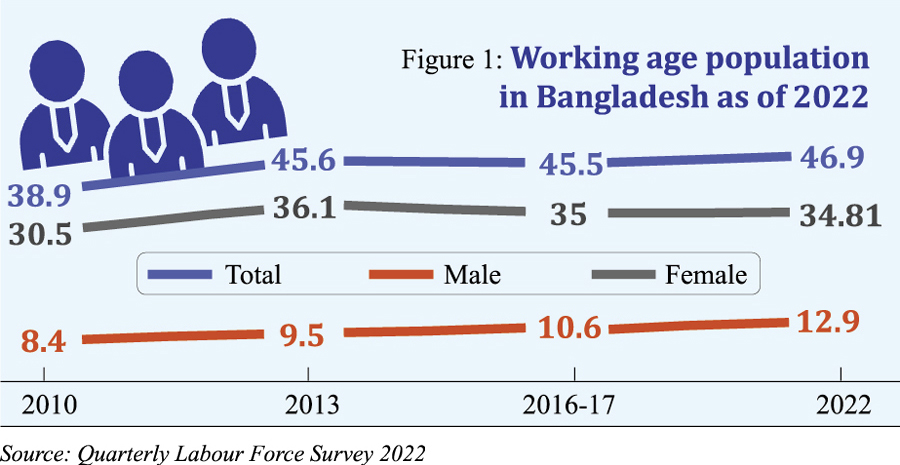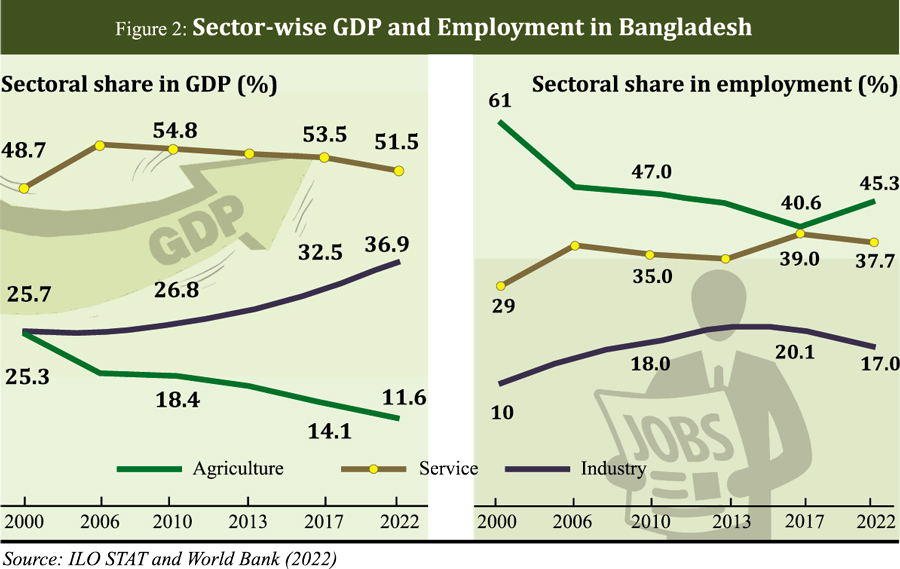 Bangladesh economy has been growing fast for the past two decades. Among different contributors to this economic growth, ready-made garment (RMG) and remittance are the clear champions without any contention. Both the contributors are highly labour-intensive, enhancing the significance of the labour market and its relevance more important than any other economic and social factors of the country. Over the past two decades, Bangladesh has emerged as one of the fastest-growing economies in the world with a consistent per-capita GDP growth of more than 6.0 percentage points. In addition, the country has been experiencing political stability, stable macroeconomic performance, and robust geopolitical support which are inducing positive confounding factors for the country. However, with this growing economy and social cohesion, Bangladesh has a big challenge to pull off economic growth and prosperity towards economies of scale and inclusive development for all. That big challenge is dealing with the labour market efficiently by producing decent job scopes with an active and increasing participation of the youth.
Bangladesh economy has been growing fast for the past two decades. Among different contributors to this economic growth, ready-made garment (RMG) and remittance are the clear champions without any contention. Both the contributors are highly labour-intensive, enhancing the significance of the labour market and its relevance more important than any other economic and social factors of the country. Over the past two decades, Bangladesh has emerged as one of the fastest-growing economies in the world with a consistent per-capita GDP growth of more than 6.0 percentage points. In addition, the country has been experiencing political stability, stable macroeconomic performance, and robust geopolitical support which are inducing positive confounding factors for the country. However, with this growing economy and social cohesion, Bangladesh has a big challenge to pull off economic growth and prosperity towards economies of scale and inclusive development for all. That big challenge is dealing with the labour market efficiently by producing decent job scopes with an active and increasing participation of the youth.
 Concomitant with this growth trajectory, Bangladesh is reaching the milestone of graduating out of the Least Developed Countries (LDC) status by 2026. In this process of LDC graduation, the country will have to overcome several socioeconomic challenges. Labour market and employment challenges will be among the crucial and complex challenges that Bangladesh must prepare for in the upcoming years. Otherwise, the country may get caught up in a long-term middle-income trap with no real growth and development. Therefore, it is pivotal to formulate appropriate policies and focus on time-bound implementation of those for resilient and sustainable growth.
Concomitant with this growth trajectory, Bangladesh is reaching the milestone of graduating out of the Least Developed Countries (LDC) status by 2026. In this process of LDC graduation, the country will have to overcome several socioeconomic challenges. Labour market and employment challenges will be among the crucial and complex challenges that Bangladesh must prepare for in the upcoming years. Otherwise, the country may get caught up in a long-term middle-income trap with no real growth and development. Therefore, it is pivotal to formulate appropriate policies and focus on time-bound implementation of those for resilient and sustainable growth.
Employment and jobs on labour market at a glance: Over the past decades, the labour market has had a dynamic shift by going from a low-to a high-growth sector, employing female workers, and incorporating a large number of the young population into it. Currently, about 2.2 million people join the job market every year. However, some challenges persist. As Bangladesh graduates from LDC, the shift from low- to high-growth sectors needs to accelerate and formal job sectors need to expand. The current job market faces barriers to expanding formal job sectors and absorbing the surge of the young population that is entering the market. The greater share of the working-age population also provides a limited window of opportunity to employ a large number of workers.
 From the supply side, workers also need skill development to adapt to the shift. Otherwise, there will be structural and technological unemployment as the country moves to industrial production. Along with job creation, the quality of the job and employment have to be given significant focus. Enhancing a good working environment and ensuring labour rights could also provide Bangladesh with international support that would otherwise be missed out.
From the supply side, workers also need skill development to adapt to the shift. Otherwise, there will be structural and technological unemployment as the country moves to industrial production. Along with job creation, the quality of the job and employment have to be given significant focus. Enhancing a good working environment and ensuring labour rights could also provide Bangladesh with international support that would otherwise be missed out.
Female labour-force participation and migrant issues are particularly important as they share a significant portion of the country's economy. For the migrant workers, ensuring their safety, protecting against human trafficking, reintegrating them into the domestic labour market, and developing their skills could empower them. On the other hand, there needs to be a specific focus on female labour-force participation specifically on the decreasing rate of urban female workers. Though female labour-force participation has increased in Bangladesh, it is mostly attributed to agriculture and rural work which impose a critical question of whether Bangladesh is going backward towards de-industrialisation. A rapid structural shift could create employment opportunities as well as address underemployment. The decreasing rate of urban working women exacerbates the stagnant apparel sector.
In addition to that, some challenges need to be considered. Although NEP 2022 correctly identified the issues, it didn't address strategies to tackle them. There needs to be a national action plan and policy directions to implement the issues discussed. In terms of monitoring the informal sector and creating a labour-related database, there is a gap between feasibility and goals.
Implementing some aspects also poses legal obstacles and requires legal instruments such as labour-related policies and social insurance. That is why some terms and concepts should be thoroughly defined and the document should be legally binding. Moreover, the unemployment issue should include multiple indicators and there needs to be more discussions on the safety, health, and protection of workers at home and abroad. Lastly, Bangladesh hasn't ratified some ILO conventions and recommendations that are essential for implementing NEP 2022 in a time-bound manner.
Global context: Like many other developing nations, the biggest issue in Bangladesh's labour market is lack of quality jobs that will ensure workers' safety, reduce the gender gaps, provide substantial wages and protect labour rights.
In terms of structural shifts, lower-middle-income countries and Bangladesh greatly lack in creating jobs in high-growth sectors like manufacturing. Although the share of employment in low-growth sectors like agriculture is decreasing, the greater share is moving to the service sector instead of the manufacturing sector. Without rapid industrial growth, the countries are at risk of falling into the middle-income trap. The key driver of this transformation is trade which has decreased globally. The trade-GDP ratio of Bangladesh has also decreased sharply over the last decade because of supply-chain disruption and lack of diversification. This area needs more discussions to stimulate the country's employment rate.
These issues need to be addressed with coordination between stakeholders and proper implementation of policies such as the newly adopted National Employment Policy of Bangladesh (NEP). The current NEP has identified important areas of intervention but lacks a robust implementation plan. Moreover, it is formulated fully based on the supply-side ingredients such as skills development, TVET and entrepreneurship development etc. It missed out on the demand-side factors such as creating jobs and investing for creating decent jobs. There are more challenges on the labour market but here the writer is mentioning only a few of them which are major in terms of priorities for the next 10 years.Following are the key labour-market challenges in Bangladesh in the wake of LDC graduation.
Unutilised youth and female labourers: Although the youth-and female labour-force participation rates have increased, they are still very low compared to the potential. Both of the demographics' Not in Education, Employment, and Training(NEET) rate is also very high, especially the female- youth-population NEET rate has been significantly high over the years. Such a scenario speaks about huge population being underutilised and loss of potential economic growth. Moreover, public spending on education in Bangladesh is also one of the lowest in the world with 1.72 per cent of GDP on average, which is a barrier to fostering a skilled, productive working population.
Low level and slow employment generation in high-growth sector: Industry share of GDP has increased which indicates a structural change. However, the employment share has decreased in industry and increased in agriculture which is known as a low-growth sector. Industries that are known for high employment generation, like the RMG sector, have been stagnant as well. A potential reason for this decreasing trend can be the use of automation and capital-intensive technology.
Migrant workers' protection and skill: Beyond the domestic market, the international labour market is generating promising scope for employment. Bangladesh has successfully sent 12.1 million workers so far with an increasing trend of remittance inflow. However, most of the workers are less-or semi-skilled as opposed to only 30% skilled labourers. Migrant workers also lack the necessary safety and protection abroad, which affects especially female workers. Inefficient enforcement, insufficient support, and lack of knowledge lead to migrants being exploited and limited remittance inflow.
Weak labour rights: Despite the existence of the Bangladesh Labour Act, it remains inaccessible because of the huge percentage of informal-sector employment and lack of awareness. There are also challenges in the lack of enforcement and leniency in penalties. Functioning legal procedures and proper labour rights can reduce inequality, increase competitiveness on a global market that will increase exports, and ensure sustainability, human rights, and social equity. There is also an increased significance of environmental, social, and governance(ESG) factors in the international trade landscape without which Bangladesh might lose bargaining power and international interest in investment. Therefore, ESG and labour rights are determining factors for growth and trade in the coming days.
Last, but by no means the least, comes the point of lack of social protection. The working-age population, especially those in the urban informal sector, doesn't have any effective and shock-responsive social-protection measures. In the light of that, the government is establishing the National Social Insurance Scheme that will provide support to the working-age group. However, the implementation process should be rapid and follow ILO conventions and recommendations for a sustainable insurance scheme. Moreover, there is insufficient institutional capacity to ensure proper implementation and a well-designed Active Labour Market Policies framework.
Mohammad Nazmul Avi Hossain is a Labour Economist, working for the ILO and can be reached at nazmulavi@gmail.com.
(This opinion piece is fully the author's personal view and analysis. It has no organisation link.)
© 2025 - All Rights with The Financial Express
